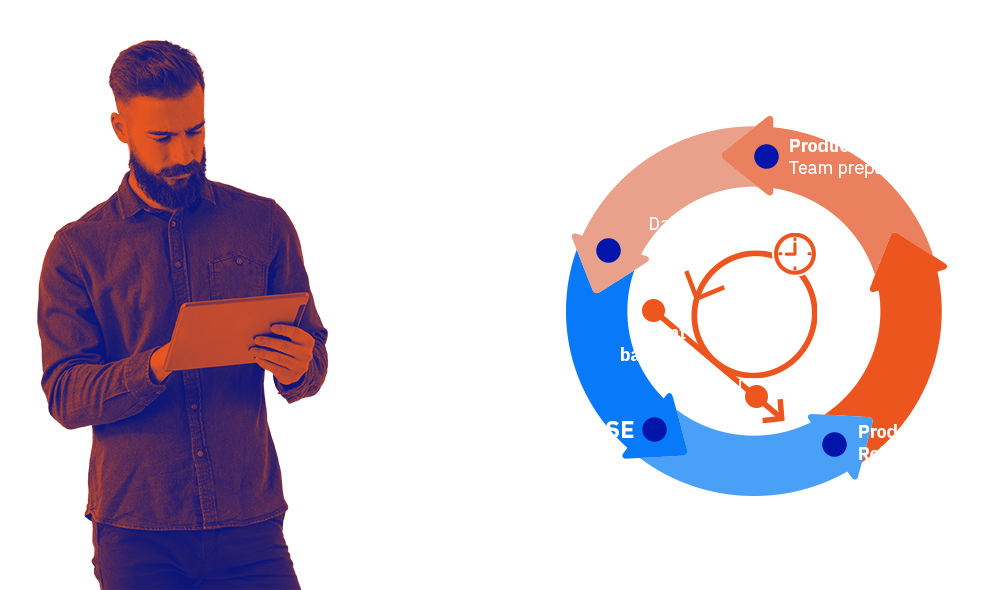Injecting the right capability at just the right time, and generating a fast ROI – in other words, how to be agile
Agility: everyone’s talking about it, but not many businesses are actually putting it into practice. And that’s for a good reason – being agile requires diligence, maturity and, above all, transparency.
Pentalog has focused on IT product development for more than 25 years, and on agile project management for over 15, leveraging this depth of experience to benefit our customers. We’ve not only mastered every fundamental feature of Scrum, but we’ve also improved them with our own homegrown recipe. This is based on our ability to provide the right skillset at the right time and ensure transparency at every stage of the process. Nothing more, nothing less – but exactly what’s required to guarantee that a product quickly generates value.
Why adopt the Scrum method?
Scrum’s 1st advantage: responsiveness
Scrum works against the black box or tunnel effect – the period between product specification and product delivery. Customers are kept in the dark about what happens in the meantime. The relationship between customer and service provider is neatly partitioned and sealed off, each in their separate place.
Scrum divides work into a series of sprints or 1 to 3-week cycles. Before starting, we produce a backlog, listing everything the development team will need to carry out its work. At the end of each sprint, we supply a deliverable that the customer can use immediately. Fast, regular deliveries ensure that we can monitor the product, checking it meets expectations, and quickly integrating any necessary changes into the following sprint.
Scrum’s 2nd advantage: adaptability
Anticipating change and acquiring the best possible capabilities won’t prevent changes to the product. The initial idea inevitably changes, first, during development, and then in response to user feedback, which may cause us to rethink certain features.
By segmenting production, Scrum ensures that the first version is ready for testing after just a few sprints. Users can try the product and provide feedback, which helps the team to refine it bit by bit.
For a project to run smoothly, we must list everything needed for a series of three sprints (or six weeks) in the backlog. Production continues at the same time so that we can reorient the product if necessary.
Scrum gives you better product visibility and lets you incorporate changes quickly.


Add layers to create business value quickly
Knowing how to put Scrum principles into practice is well and good, but what else can we do to help your business grow and prosper?
We can supply the right strengths at the right time. There’s no waste of time or resources, just added business value.
A classic Scrum team consists of at least two developers, one tester, one Scrum Master, and one Product Owner.
Pentalog adds extra layers to this team to help us focus on the added value a digital product can bring to your business. It can be about product design with a UX/UI designer, security with an Ethical Hacker, infrastructure optimization with a DevOps, or digital marketing with a PPC or Marketing Automation expert. Our goal is to prioritize the tasks in the backlog so that they tell a constructive story and generate ROI very quickly.
Pentalog has 1,300 tech and digital specialists who are ready to come and work on your project at any time, either as a one-off for a particular sprint or throughout the entire product life cycle.
Transparency at every level with our Collaboration Framework
With over 25 years’ experience in digital product development, including 15 years of Agility experience, the 1,500 or so products we have developed have allowed us to try, validate, and improve different working methods. We kept the very best of them and gathered them together in our Collaboration Framework.
The Collaboration Framework is a support system comprised of elements integral to Agility (velocity, burn down chart) and others that Pentalog has specifically created and added, such as team mood, budget, and the HR vision. The purpose of the Collaboration Framework is to avoid any misunderstandings during collaboration. It sets out in detail how teams will interact during the project, each person’s role, and rules everyone must follow for a successful project.
The Collaboration Framework ensures total transparency between everyone involved in the project.
By combining the Scrum method with our Collaboration Framework, we give our customers and our teams a safe, scalable working framework to help them view the collaboration with equanimity.
When project management and success go hand-in-hand
We appoint a project director to ensure that both the Scrum method and the Collaboration Framework are followed. They also monitor the well-being of team members and the smooth execution of the project, including staying within budget and meeting deadlines. The project director acts as a link between the customer, development teams, and Pentalog.
The project director must have a wide variety of skills – the ability to organize teams, IT skills to recommend the best technologies, legal and financial knowledge to help sales teams execute contracts that meet the customer’s requirements and budget, KPI and modifications monitoring if necessary. A project director only successfully completes their mission if they respect the terms of the contract and satisfy both the customer and the teams involved.
Reach out to us,
describe your project
Choose a development category
Software
development
development
Mobile
development
DevOps
UX/ UI
design
QA Testing
Security
Technical
Due Diligence




